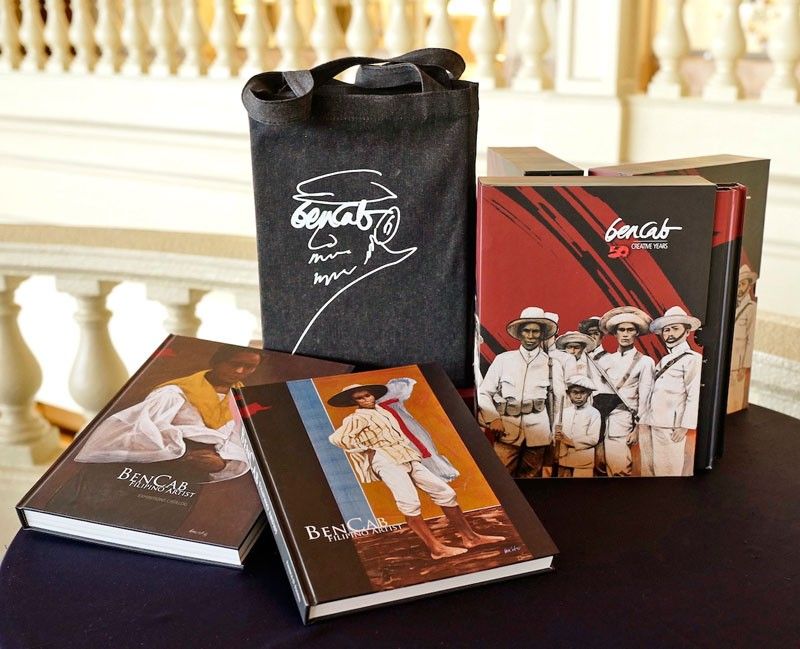Twin books on BenCab’s 50 creative years


On Sept. 25 at The Peninsula Manila, a double launch was held to celebrate the continuing supremacy of National Artist Benedicto “BenCab” Cabrera as our country’s premier visual artist.
At the main lobby, launched was the “BenCab + Moooi Carpets Series 7” with this striking new medium bearing BenCab’s artworks, which was on view until Oct. 13.
The upper lobby saw the launch of the twin-volume BenCab: Filipino Artist, authored by Patrick D. Flores and published by BenCab Art Foundation, Inc. Contributing writer was Cid P. Reyes, with Dannie R. Alvarez as editorial director, Perfecto T. Martin as copy editor, Mervin Concepcion Vergara as principal book designer, and Jon Roxas as contributing graphic designer.
Wig Tysmans is credited with principal photography, while contributing photography was furnished by BenCab, Jax C. Mariano, Peter John Natividad, Ed Santiago and Romy Vitug, along with the Ayala Museum. BenCab Archives, Singapore Tyler Print Institute and University of the Philippines.
Exhibition curators are also listed: Alvarez, BenCab, Flores, Ma. Victoria T. Herrera and Ambeth R. Ocampo. All of these eminent associates became necessary for such an ambitious project, one that has resulted in a superb twin-volume set housed in an elegant slipcase that is in turn sheathed in a signature bag.
Also billed as the “BenCab 50 Creative Years books,” the twin volumes with different covers offer the definitive evaluation and parade of images representing a half-century of exceptional art, beginning with an inspired assessment that only Flores could have written.
The first volume also includes an important chapter titled “The Artist’s Voice” the memorable 1978 interview conducted in detail by Cid Reyes in London when Ben was beginning to find his exalted way in the international art world. This interview was the first to uncover and expound on Ben’s early fascination with the barong-barong for his first exhibit in the mid-1960s, as well as his breakthrough with the iconic Sabel the scavenger as subject, and of Pit-a-pit, the young Igorot, boy as “an example of a Filipino who had undergone the process of colonization.”
The second volume covers BenCab’s 50-year retrospective exhibitions held in eight museums, with the curators contributing essays for the accompanying catalogue.
Honoring Ben with the Foreword in the first book is his fellow National Artist (for Literature) Virgilio S. Almario, who remarks:
“As writer and observer of Philippine life, I admire the dynamic signifying potential of BenCab’s images. Like words that bear the weight of context and the grace of insight, they lead the viewer to both self and society. The details of persons and things that dwell in the paintings of BenCab have become watersheds in Philippine art history. They speak to intimate lives and the vast social milieu.”
For his major part, Flores constructs and fleshes out the backbone for the artist’s creative compendium with such astute reckoning and articulation that turn into an outstanding diagnosis and translation of an artist’s evolving creative efforts.
In his Preface, Flores writes: “In the attempt to disabuse the mystifications of Cabrera’s form, the essays, interview, and timeline here round out an artistic disposition, and not merely affirm a reputation. The volume centers on the modern form through the devices of the grid, the drape, and the stain. They are assessed not merely formalistically but as indices to a Philippine interest, a term that references the artist’s sensitivity to art and society.”
The formalistic rendering needs no apologia. In his unveiling of these “Devices of Philippine Interest,” Flores references older artists Victorio Edades, Arturo Luz, Alfredo Roces, poet-critics Ricaredo Demetillo and Perfecto Terra, Jr., artists/critics Raymundo Albano, Cid Reyes and Alice Guillermo in relation to BenCab’s evolution as a draughtsman, illustrator, graphic artist, painter and sculptor.
All this while he essays his own expert calculations, as when he writes on Ben’s fundamental reliance on the grid: “In the work of Cabrera over the years, the line inevitably coheres into an imagined structure of the grid. The grid is the framework within which a certain current of line circulates. It isolates the form, invests it with integrity that is in turn enhanced by more lines to generate a more fulsome silhouette, greater depth, or sharper density. Also, it is the basis of a range of iterations and comparisons.”
Then, on the “Drape”: “Through the drape, the form is animated, made vulnerable to the elements, to chance, and to eccentricity. It is the drape that offers the artist the opportunity to open up to gesture as opposed to representation or theme. This is a challenge for the graphic form within the grid.”
And finally, on BenCab’s utilization of the “Stain”: “With the graphic and the calligraphic, the grid and the gesture coming to ingrain context in the material, the latter finally generates its own context, or better to say, the ability to create a system of signs in which the graphic material and the calligraphic gesture become a discursive event. This requires a mediation of another aspect in Cabrera’s aesthetic, perhaps an ornament that further widens the purview of the skill and the style. This happens to be the stain that layers over the surface and disperses the signifying character of color.”
Further, invaluably: “In Cabrera’s sensorium, it is the chroma of the photograph or the document. It represents a melancholic moment in the reflection of the artist on history. He stains the figure of history to demonstrate its status as evidence or as complicit with human choices and decisions.”
A generous display of works attests to these devices as divined in Flores’ commanding architectonics of BenCab’s art. Of course, one can simply satiate oneself with the images, and in lieu of literary appreciation, aver that Ben Cabrera has claimed his enviable pedestal by virtue alone of consummate genius plus doses of good joss. After all, he alone as a supreme artist enjoys proprietary privilege over forested mountains, waterfalls, a river and a pond-strewn farm as his habitat, not to mention a museum with a café.
For the second volume, subtitled “Exhibitions Catalog,” Joven R. Cuanang writes in the Foreword: “His creative energies through the years have been boundless. His interest in the Filipino, earnest. Wherever he went, he depicted the Filipino in all our nobility, despair, and capacity to endure.”
For those in want of an actual BenCab artwork, these twin volumes are an alternative option, for one may own appreciation of hundreds of images covering half-a-century’s superlative art.
Apart from the BenCab Museum in Baguio City, they are currently available at Yuchengco Museum, UP Vargas Museum, Ateneo Art Gallerty, Abitare Internazionale, and soon at Solidaridad Bookstore.



















